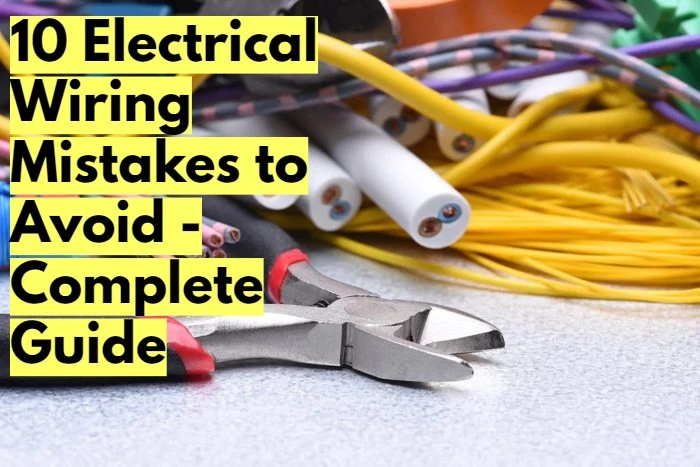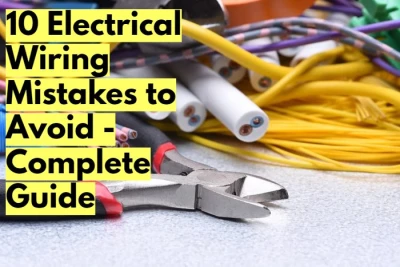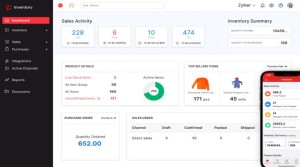10 Electrical Wiring Mistakes to Avoid
In any building, electrical wiring is like the veins that carry electricity everywhere.

In any building, electrical wiring is like the veins that carry electricity everywhere. It's important to get it right so that the electricity is safe and works well. But if mistakes are made, it can be dangerous and cause fires, shocks, or broken appliances.
This article will explain 10 common electrical wiring mistakes you should avoid, no matter if you're an electrician or someone who likes to fix things yourself. We'll cover things like what not to do with wires, how to connect them properly, and how to stay safe around electricity. By the end, you'll know how to handle electrical wiring safely and avoid problems.
10 Common Electrical Mistakes that Anyone Should Avoid
Every rational person keeps oneself away from such mistakes that can be harmful or dangerous for life. Therefore, safety measures are important to be taken and implemented properly. Here are given 10 common electrical mistakes that anyone should avoid.
1. Improper Grounding
A big mistake that people mostly forget is grounding their electrical stuff. Grounding is like a special wire that takes extra electricity away. Make sure all your plugs, switches, and lights have that grounding wire in place for safety.
2. Overloaded Circuits
Connecting too many things at once can heat up your wires and cause a fire. To avoid this, try spreading your appliances across different outlets and use the correct circuit breaker for each area.
3. Using the Wrong Wire Size
Big appliances, like ovens, need thick wires to handle their strong electrical current. Small appliances such as lamps use thin wires. Using the wrong wire size is dangerous. It can overheat and cause a fire. So, always use the right size wire for your appliance.
4. Loose Connections
Unsafe electrical connections can cause your power to cut in and out sometimes. They can also make sparks, which causes a fire danger. Make sure all the connections are safe.
5. Incorrect Outlet Installation
Putting in plugs wrong, like mixing up the hot and regular wires, can make it dangerous to touch them and cause a shock. To be safe, always follow the instructions that come with the plug and what the local rules say.
6. Neglecting Grounding and Bonding
Everyone needs an extra zap for a save life. This is called grounding. It protects you and your appliances from getting a big shock if something goes wrong with the electricity. If grounding isn't done properly, you could get a nasty shock.
7. Ignoring Electrical Code Requirements
Electrical codes are like a rule book to keep your home safe from electricity problems. If you ignore these rules when working on your wires, it could be dangerous for you and your family.
8. Lack of GFCI Protection
GFCI (Ground Fault Circuit Interrupter) outlets provide additional protection in areas prone to moisture, like kitchens and bathrooms. Skipping GFCI outlets can increase the risk of electrical shock in case of water contact.
9. Using Incorrect Wiring Techniques
There are special ways to connect electrical outlets, switches, and lights. Improper use can make the electrical system unsafe, and might even affect its performance.
10. Neglecting Electrical Inspections
It is very important to have a skilled electrician check your home's electrical wiring regularly. In this way, they can quickly solve small problems before they become bigger problems.
How to Connect Electrical Wires for Proper Performing?
Making sure the electrical wires are connected correctly is very important. This will keep your electrical system safe and working properly.
-
Splice Connections
When you connect wires together, use special things called connectors. These can be like small wire or metal clamps. Don't just use regular tape on its own, as it can wear off.
-
Securing Connections
Use junction boxes to house all splices and connections. This protects the connections from physical damage and provides a barrier against fire spread.
-
Labeling Wires
Properly label all wires to avoid confusion during future maintenance or repairs. This helps ensure that each wire is connected correctly and safely.
How to Nicely Twist the Electrical Wires?
Joining electrical wires by twisting them together is something people often do, but it's important to do it carefully to keep things safe and working properly.
-
Proper Twisting Technique
When you connect wires, screw on a little cap called a wire nut to hold them together. Twist the wires tightly before putting on the nut. Make sure no shiny metal parts of the wires stick out from under the nut. This keeps the wires from sparking and touching each other, and it makes a good connection for electricity to flow.
-
Use of Wire Nuts
There are different sizes of wire nuts, choose one that fits the wires you are connecting. Over tightening the nut can mess up the wires, and under tightening can weaken the connection. Therefore, it is very important to understand its configuration.
Pros and Cons of Proper Electrical Wiring Practices
Pros
- Reduces the risk of electrical fires and shocks.
- Ensures optimal performance of electrical devices.
- Meets local codes and regulations, avoiding legal issues.
- Increases the lifespan of electrical systems and appliances.
- Reduces the frequency of electrical problems and interruptions.
Cons
- Proper installations can be more expensive upfront.
- Thorough planning and execution take more time.
- Requires a good understanding of electrical principles and local codes.
How to Effectively Follow Electrical Safety Rules?
It's very important to follow electrical safety rules. This will help keep you safe from getting hurt and will make your electrical appliances last longer.
-
Regular Inspections
You should check your electrical stuff regularly to make sure nothing is broken. Look for wires that are coming apart, outlets that look burned, or anything else that seems wrong. In this way, you can catch problems even before they occur or become big.
-
Safety Equipment
Before touching electrical equipment, wear special gloves that will not shock you. Also, wear safety glasses to protect your eyes. Use tools with special handles that are also non-electric. This will help keep you safe.
-
Follow Codes and Standards
When working with electricity, always follow the rules in your area. These rules are there to keep you safe and make sure things are done properly.
-
Turn Off Power
Make sure there's no electricity running before you fix anything electrical. First, turn off the power switch for that area at the fuse box. Then, use a special tool called a voltage tester to double check that no electricity is coming out of the wires before you touch them.
What an Electricity Calculator Can Do For You?
Using an electricity calculator can help plan electrical installations and ensure that circuits are not overloaded.
Calculating Load Requirements
An electricity calculator is a tool that helps you figure out how much power you can safely use in a single outlet or circuit. It adds up the amount of electricity that all of your devices use to make sure the circuit isn't overloaded. If the circuit gets overloaded, it might trip a breaker or overheat, which could be dangerous.
Planning Circuit Distribution
Figuring out how much power your appliances use (called the load) helps you spread them out safely across different electrical circuits. This prevents any one circuit from getting overloaded and helps your whole electrical system working smoothly.
Overall, doing electrical work right is important to keep your house safe and working well. There are common mistakes people make, like putting too many things on one circuit, not grounding things properly, or using the wrong wire connections. If you know about these mistakes, you can avoid problems like fires, shocks, and expensive repairs. To do the job safely, follow the electrical rules in your area, use the right tools and parts, and take your time planning things out. It's always better to do it right the first time than to have to fix something later that went wrong. By following these tips, you can keep your electrical system safe and feel reliable about your home wirings.

In any building, electrical wiring is like the veins that carry electricity everywhere. It's important to get it right so that the electricity is safe and works well. But if mistakes are made, it can be dangerous and cause fires, shocks, or broken appliances.
This article will explain 10 common electrical wiring mistakes you should avoid, no matter if you're an electrician or someone who likes to fix things yourself. We'll cover things like what not to do with wires, how to connect them properly, and how to stay safe around electricity. By the end, you'll know how to handle electrical wiring safely and avoid problems.
10 Common Electrical Mistakes that Anyone Should Avoid
Every rational person keeps oneself away from such mistakes that can be harmful or dangerous for life. Therefore, safety measures are important to be taken and implemented properly. Here are given 10 common electrical mistakes that anyone should avoid.
1. Improper Grounding
A big mistake that people mostly forget is grounding their electrical stuff. Grounding is like a special wire that takes extra electricity away. Make sure all your plugs, switches, and lights have that grounding wire in place for safety.
2. Overloaded Circuits
Connecting too many things at once can heat up your wires and cause a fire. To avoid this, try spreading your appliances across different outlets and use the correct circuit breaker for each area.
3. Using the Wrong Wire Size
Big appliances, like ovens, need thick wires to handle their strong electrical current. Small appliances such as lamps use thin wires. Using the wrong wire size is dangerous. It can overheat and cause a fire. So, always use the right size wire for your appliance.
4. Loose Connections
Unsafe electrical connections can cause your power to cut in and out sometimes. They can also make sparks, which causes a fire danger. Make sure all the connections are safe.
5. Incorrect Outlet Installation
Putting in plugs wrong, like mixing up the hot and regular wires, can make it dangerous to touch them and cause a shock. To be safe, always follow the instructions that come with the plug and what the local rules say.
6. Neglecting Grounding and Bonding
Everyone needs an extra zap for a save life. This is called grounding. It protects you and your appliances from getting a big shock if something goes wrong with the electricity. If grounding isn't done properly, you could get a nasty shock.
7. Ignoring Electrical Code Requirements
Electrical codes are like a rule book to keep your home safe from electricity problems. If you ignore these rules when working on your wires, it could be dangerous for you and your family.
8. Lack of GFCI Protection
GFCI (Ground Fault Circuit Interrupter) outlets provide additional protection in areas prone to moisture, like kitchens and bathrooms. Skipping GFCI outlets can increase the risk of electrical shock in case of water contact.
9. Using Incorrect Wiring Techniques
There are special ways to connect electrical outlets, switches, and lights. Improper use can make the electrical system unsafe, and might even affect its performance.
10. Neglecting Electrical Inspections
It is very important to have a skilled electrician check your home's electrical wiring regularly. In this way, they can quickly solve small problems before they become bigger problems.
How to Connect Electrical Wires for Proper Performing?
Making sure the electrical wires are connected correctly is very important. This will keep your electrical system safe and working properly.
-
Splice Connections
When you connect wires together, use special things called connectors. These can be like small wire or metal clamps. Don't just use regular tape on its own, as it can wear off.
-
Securing Connections
Use junction boxes to house all splices and connections. This protects the connections from physical damage and provides a barrier against fire spread.
-
Labeling Wires
Properly label all wires to avoid confusion during future maintenance or repairs. This helps ensure that each wire is connected correctly and safely.
How to Nicely Twist the Electrical Wires?
Joining electrical wires by twisting them together is something people often do, but it's important to do it carefully to keep things safe and working properly.
-
Proper Twisting Technique
When you connect wires, screw on a little cap called a wire nut to hold them together. Twist the wires tightly before putting on the nut. Make sure no shiny metal parts of the wires stick out from under the nut. This keeps the wires from sparking and touching each other, and it makes a good connection for electricity to flow.
-
Use of Wire Nuts
There are different sizes of wire nuts, choose one that fits the wires you are connecting. Over tightening the nut can mess up the wires, and under tightening can weaken the connection. Therefore, it is very important to understand its configuration.
Pros and Cons of Proper Electrical Wiring Practices
Pros
- Reduces the risk of electrical fires and shocks.
- Ensures optimal performance of electrical devices.
- Meets local codes and regulations, avoiding legal issues.
- Increases the lifespan of electrical systems and appliances.
- Reduces the frequency of electrical problems and interruptions.
Cons
- Proper installations can be more expensive upfront.
- Thorough planning and execution take more time.
- Requires a good understanding of electrical principles and local codes.
How to Effectively Follow Electrical Safety Rules?
It's very important to follow electrical safety rules. This will help keep you safe from getting hurt and will make your electrical appliances last longer.
-
Regular Inspections
You should check your electrical stuff regularly to make sure nothing is broken. Look for wires that are coming apart, outlets that look burned, or anything else that seems wrong. In this way, you can catch problems even before they occur or become big.
-
Safety Equipment
Before touching electrical equipment, wear special gloves that will not shock you. Also, wear safety glasses to protect your eyes. Use tools with special handles that are also non-electric. This will help keep you safe.
-
Follow Codes and Standards
When working with electricity, always follow the rules in your area. These rules are there to keep you safe and make sure things are done properly.
-
Turn Off Power
Make sure there's no electricity running before you fix anything electrical. First, turn off the power switch for that area at the fuse box. Then, use a special tool called a voltage tester to double check that no electricity is coming out of the wires before you touch them.
What an Electricity Calculator Can Do For You?
Using an electricity calculator can help plan electrical installations and ensure that circuits are not overloaded.
Calculating Load Requirements
An electricity calculator is a tool that helps you figure out how much power you can safely use in a single outlet or circuit. It adds up the amount of electricity that all of your devices use to make sure the circuit isn't overloaded. If the circuit gets overloaded, it might trip a breaker or overheat, which could be dangerous.
Planning Circuit Distribution
Figuring out how much power your appliances use (called the load) helps you spread them out safely across different electrical circuits. This prevents any one circuit from getting overloaded and helps your whole electrical system working smoothly.
Overall, doing electrical work right is important to keep your house safe and working well. There are common mistakes people make, like putting too many things on one circuit, not grounding things properly, or using the wrong wire connections. If you know about these mistakes, you can avoid problems like fires, shocks, and expensive repairs. To do the job safely, follow the electrical rules in your area, use the right tools and parts, and take your time planning things out. It's always better to do it right the first time than to have to fix something later that went wrong. By following these tips, you can keep your electrical system safe and feel reliable about your home wirings.
Conversation
Latest Blogs
© Blog CoolCalculator, Explore CoolCalculator, your destination for the latest insights, tips, and updates on the world of online calculators. Stay informed and make your calculations smarter with our blog. ,
Designed
by Saad Media Team , Team Lead M.Rizwan Akhtar












